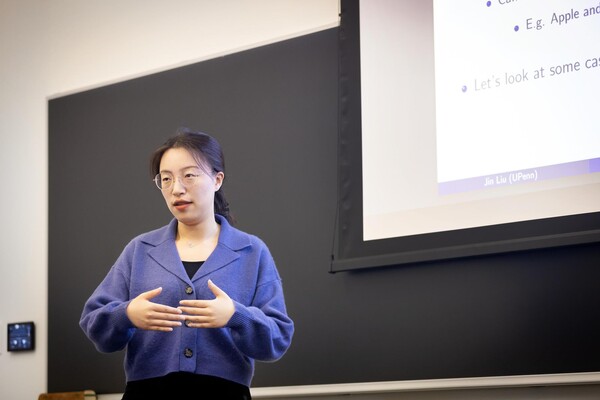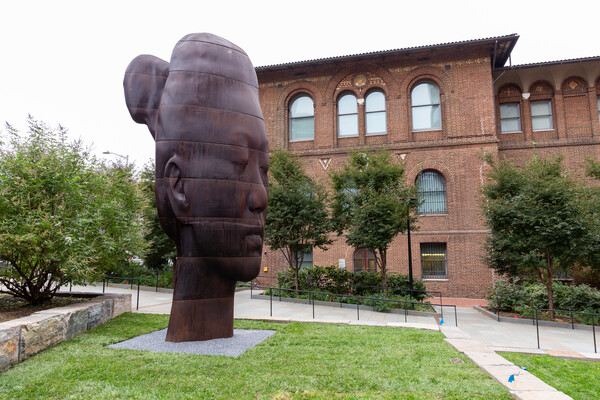
(From left) Doctoral student Hannah Yamagata, research assistant professor Kushol Gupta, and postdoctoral fellow Marshall Padilla holding 3D-printed models of nanoparticles.
(Image: Bella Ciervo)
6 min. read

From the mud, straw, and gypsum mixtures of ancient Egypt’s monumental pyramids to the sophisticated underwater material employed by Roman engineers in iconic structures like the Pantheon, concrete has long symbolized civilization’s resilience and ingenuity.
Yet today, concrete finds itself in a paradoxical bind: The very material that allowed societies to flourish is also responsible for up to 9% of global greenhouse gas emissions. Climate change, itself deeply rooted in fossil fuel use, presents humanity with an existential challenge if people seek to sustainably build the structures that support modern life—namely, new homes, highways, bridges, and more.
Now, designers, materials scientists, and engineers from the University of Pennsylvania have teamed up to create a biomineral-infused concrete by blending 3D printing with the fossil architecture of microscopic algae. This concrete is remarkably lightweight—yet structurally sound—and captures up to 142% more CO₂ than conventional mixes while using less cement and still meeting standard compressive-strength targets.
The key ingredient is diatomaceous earth (DE), a popular filler material made from fossilized microorganisms. The researchers found that the fine, porous, and sponge-like texture of DE not only improves the stability of concrete as it’s pushed through a 3D printer nozzle but also provides abundant sites for trapping carbon dioxide. These findings, which are reported in Advanced Functional Materials, pave the way for building materials that both hold up bridges and skyscrapers and help restore marine ecosystems and capture carbon from the air.
“Usually, if you increase the surface area or porosity, you lose strength,” says co-senior author Shu Yang, the Joseph Bordogna Professor of Engineering and Applied Science and Chair of the Department of Materials Science at the School of Engineering and Applied Science. “But here, it was the opposite; the structure became stronger over time.”
She notes that the team not only achieved “an additional 30% higher CO₂ conversion” when the geometry of the material was further optimized but did so while maintaining a compressive strength comparable to ordinary concrete. “It was one of those rare moments where everything just worked better and looked nicer,” she says.
“But it wasn’t just about aesthetics or reducing mass,” adds co-senior author Masoud Akbarzadeh, associate professor of architecture at the Weitzman School of Design. “It was about unlocking a new structural logic. We could reduce material by almost 60%, and still carry the load, showing it’s possible to do so much more with so much less.”
Yang saw potential in applying her materials science expertise towards imbuing the gravel, cement, and water mixture of concrete with carbon-capture properties.
“I didn’t know much when we first started,” she says, “but I understood that rheology—how particles flow and interact—was crucial to how concrete behaves during mixing and printing.”
To translate that understanding into a viable 3D-printing formulation, she leaned on the experience of her former postdoctoral researcher and first author of the paper, Kun-Hao Yu, who had previously worked with concrete in civil engineering and additive manufacturing contexts.
“Concrete isn’t like conventional printing materials,” Yu explains. “It has to flow smoothly under pressure, stabilize quickly after extrusion, and then continuously strengthen as it cures.” That complexity, he says, made it an ideal challenge to apply a mix of chemistry, physics, and design thinking.
At the same time, Yang had been revisiting diatomaceous earth, which she had previously encountered in studies of natural photonic crystals and carbon sinks in the Southern Ocean, where diatoms help reduce greenhouse gases by ferrying CO₂ to the sea floor when they die. Diatoms—a kind of ancient microscopic algae—construct intricate, porous silica shells that, over millions of years, have accumulated into the DE now used in everything from pool filters to soil additives.
“I was intrigued by how this natural material could absorb CO₂,” Yang says. “And I started wondering: What if we could integrate it directly into construction materials?”
The team discovered that DE’s internal pore network not only provided pathways for carbon dioxide to diffuse into the structure but also enabled calcium carbonate to form during curing, thereby improving both CO₂ uptake and mechanical strength.
Yu led the development of the printable concrete ink, calibrating variables for the 3D printer like water-to-binder ratios, nozzle size, and extrusion speed.
“We ran a lot of trials,” he says. “What surprised us most was that despite the high porosity that normally acts an impediment to stress, the material actually got stronger as it absorbed CO₂.”
While DE optimized the material itself, geometry played an equally transformative role. Akbarzadeh and his team turned to triply periodic minimal surfaces (TPMS)—mathematically complex but naturally occurring structures found in bones, coral reefs, and sea stars. These “continuous” forms, which are devoid of sharp edges or breaks, are prized for their ability to maximize surface area while minimizing mass.
“The shapes are complex, but naturally efficient in that they maximize surface area and geometric stiffness while minimizing material,” Akbarzadeh explains. “In nature, form and function are inseparable, so we wanted to bring that principle into the arrangements of these materials.”
Using polyhedral graphic statics, a method that maps force distributions through geometry, his team designed a concrete structure that could support itself, even with steep overhangs, while remaining open and porous enough for maximum CO₂ exposure.
In graphic statics, Akbarzadeh explains, every line in the form diagram represents the force flow, allowing the team to tune how compressive and tensile forces distribute through the structure. They then coupled that with post-tensioning cables to enhance the internal stability of the concrete.
Once modeled, the forms were digitally sliced into printable layers and optimized to extrude smoothly without collapsing, sagging, or clogging the printer nozzle. The resulting printed components were tested under load and subjected to carbonated environments, which culminated in structures that used 68% less material than traditional concrete blocks while increasing their surface-area-to-volume ratio by over 500%. Additionally, the TPMS cube retained 90% of the compressive strength of the solid version and achieved a 32% higher CO₂ uptake per unit of cement.
Looking ahead, the team is advancing the work on multiple fronts including scaling up to full-size structural elements such as floors, facades, and load-bearing panels.
“We’re testing larger components with more complex reinforcement schemes,” says Akbarzadeh, referring to the embedded post-tensioning cables and force-balancing geometries that his lab specializes in. “We want these to be not just strong and efficient, but buildable at architectural scale.”
Another avenue focuses on marine infrastructure. Because of its porosity and ecological compatibility, the DE-TPMS concrete may be well-suited for structures like artificial reefs, oyster beds, or coral platforms. “We’re especially excited about deploying this in restoration contexts,” says Yang. “The high surface area helps marine organisms attach and grow, while the material passively absorbs CO₂ from the surrounding water.”
Yang’s team is also exploring how DE might work with other binder chemistries beyond industry-standard cements, such as magnesium-based or alkali-activated systems. “We want to push this idea further,” she says. “What if we could remove the cement altogether? Or use waste streams as the reactive component?”
“The moment we stopped thinking about concrete as static and started seeing it as dynamic—as something that reacts to its environment—we opened up a whole new world of possibilities,” she adds.
Shu Yang is a Joseph Bordogna Professor of Engineering and Applied Science and Chair of the Department of Materials Science & Engineering in the School of Engineering and Applied Science.
Masoud Akbarzadeh is an associate professor of architecture at the Weitzman School at Penn and director of the Polyhedral Structures Laboratory.
Kun-Hao Yu is a former postdoctoral researcher in the Shu Yang Group at Penn Engineering who is currently an assistant professor of Civil and Environmental Engineering at Syracuse University.
Other authors of the paper include So Hee Nah, Kun-Yu Wang, Yinding Chi, and Peter Psarras of Penn Engineering and Teng Teng Hua Chai, and Yefan Zhi, of the Weitzman School.
Amir Motavaselian, Maximilian E. Ororbia, and Pouria Vakhshouri of the Weitzman School and Yu Wang of Penn Engineering worked on the methodology, engineering, large scale fabrication, and material design of the structure.
This work was supported by the Department of Energy (DE-FOA-0002625) and the Vagelos Institute for Energy Science and Technology at the University of Pennsylvania.

(From left) Doctoral student Hannah Yamagata, research assistant professor Kushol Gupta, and postdoctoral fellow Marshall Padilla holding 3D-printed models of nanoparticles.
(Image: Bella Ciervo)

Jin Liu, Penn’s newest economics faculty member, specializes in international trade.
nocred

nocred

nocred